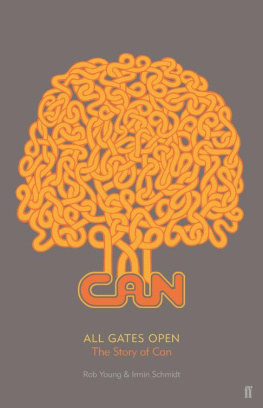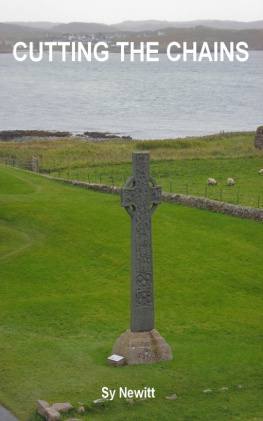
Thank you for buying this
St. Martins Press ebook.
To receive special offers, bonus content,
and info on new releases and other great reads,
sign up for our newsletters.

Or visit us online at
us.macmillan.com/newslettersignup
For email updates on the author, click here.
The author and publisher have provided this e-book to you for your personal use only. You may not make this e-book publicly available in any way. Copyright infringement is against the law. If you believe the copy of this e-book you are reading infringes on the authors copyright, please notify the publisher at: us.macmillanusa.com/piracy.
For ai and Tita
Our music is a way to express things that we wouldnt talk aboutthings that are that heavy and that dark. These are feelings that everybody experiences. Thats why people relate to it.
Jerry Cantrell
The historians task is not to disrupt for the sake of it, but it is to tell what is almost always an uncomfortable story and explain why the discomfort is part of the truth we need to live well and live properly. A well-organized society is one in which we know the truth about ourselves collectively, not one in which we tell pleasant lies about ourselves.
Tony Judt
It is the tale, not he who tells it.
STEPHEN KING
THE PAST THREE YEARS have seen a revival of interest in the Seattle grunge scene that dominated music in the early 1990s. Anniversaries of landmark albums, deaths, and actual or pending inductions to the Rock and Roll Hall of Fame have all sparked an interest in the people and place that made the music of that era. Of Seattles Big Four, Nirvana dominates most of the attention, in large part because of the life and talent of Kurt Cobain, as well as the post-Nirvana success of Dave Grohl and the controversies involving Courtney Love and the Cobain estate. Pearl Jam also draws a great deal of attention and has the distinction of being the only one of the four bands that has continuously kept going for almost twenty-five years as of this writing. Soundgarden broke up, and Chris Cornell carried on as a solo artist and as part of Audioslave, before regrouping in 2010.
But the story of Alice in Chains is the most interesting for several reasons: how Layne Staley emerged as one of the most influential vocalists of his generation, inspiring legions of imitators; their prolific output despite the relatively short period of activitythree studio albums, two EPs, and one live album during the period between 1989 and 1996; how it was the first band out of the gate in getting a nationwide following, heavy airplay on MTV, and a gold record; and also as a cautionary story of how a talented band nearly lost it all and not everyone lived to tell the tale.
At the end of the day, it comes down to the music, which lives on in peoples hearts, homes, on the radio, in films and television shows, and on the Internet. Mozart and Beethoven died centuries ago, but people are still listening to The Marriage of Figaro and the Ninth Symphony. Alice in Chains has withstood the test of time and aged well in spite of the difficult circumstances with which the band had to deal. The fact that the band continues to record new material and perform live is a testament to the enduring power and quality of their work.
In the summer of 2011, I was in between my first and second year of graduate school at Georgetown University and working at 60 Minutes . Between work and school, I had a lot on my plate, which required a lot of late-night reading. During one of these reading sessions, for no particular reason, I put on Dirt, which I hadnt listened to in a very long time. Id had it in some shape or form since 1992 or 1993first on cassette, later on CD, and now as an MP3.
I played it all the way through and was reminded of what a good album it is. At that point, I did a little bit of online research. Id heard that the band had regrouped with a new singer and released a new album. I looked online for any biography or book about them, thinking that someone must have written something in the years since Layne Staleys death, and found nothing along the lines of what I was looking for. It was at that point that I first got the idea of writing this book. I suppose my reason for writing it is similar to George Mallorys famous response to the question of why he wanted to climb Mount Everest: because its there.
I started working on the book in August 2011 as soon as my work and school obligations were done. I took the first of several reporting trips to Seattle to do on-the-ground research. Three years, dozens of on-the-record sources, and hundreds of pages of public records later, I finished what is the first biography of Alice in Chains.
Officially, the bands story began at what is now a giant hole in the ground in Ballardthe site of what once was the Music Bank, where one day in late 1987 the four founding members met and jammed for the first time. I wanted to go back further, to find out how and why the four of them got to that place at that time and what they did individually and as a group in the years after.
I should make it clear what this book is and is not.
This book was done without the cooperation of the band, their management, or their record label. It was challenging, but not impossible, to get around their policy of not commenting. I dont like the terms authorized and unauthorized biographies for different reasons. To me, authorized biographies carry a connotation of official public-relations spin, in addition to the blessing and cooperation of the subjects. That is not what this book is. On the other hand, unauthorized biographies sound like the content is sleazy, gossipy tabloid trash. That is not what this book is, either. Although drugs are part of the story, I didnt want this book to be Requiem for a Dream with a Seattle grunge setting. I also didnt want this book to read like a typical rock band biography. The approach and writing were more influenced by the works of Walter Isaacson and Bob Woodward than Stephen Davis or Mick Wallno disrespect to Mr. Davis or Mr. Wall.
This book is the improbable, funny, tragic, and ultimately triumphant story of how Alice in Chains came to be and emerged as one of the most influential bands of the Seattle grunge scene. It is also the culmination of more than a decade of experience in journalism and academia, and Ive tried to adhere to the high standards Ive encountered in both.
I never planned out my life. Shit just happens.
Layne Staley
You cant freaking sing!
KEN ELMER
LAYNE RUTHERFORD STALEY was born on Tuesday, August 22, 1967, at Overlake Hospital in Bellevue, Washington. His parents, Phillip Blair Staley and Nancy Elizabeth Layne, were living in the town of Kirkland, located along the eastern shore of Lake Washington.
Laynes birth was announced in the Born Yesterday section of the next days edition of The Seattle Times . Under the subheading To Mr. and Mrs. the section is an alphabetical listing of every child born the previous day in each hospital in the greater Seattle area. The final birth listed under Overlake Hospital reads, Phillip B. Staley, 10146 N.E. 64th St., Kirkland, boy.
Phil and Nancy, who were twenty-nine and nineteen at the time, had been married by a minister nearly six months earlier in a ceremony witnessed by Paul R. Staley, the grooms brother, and Margaret Ann Layne, the brides sister. The previous summer, Nancy had competed in the Miss Washington Pageant as Miss Bellevue. When Phil and Nancys engagement was announced in January 1967, Nancy was a student at the Cornish School of Allied Arts. She was the oldest of Robert L. Layne and Ann J. Beckers three daughters. Her parents were both graduates of the University of Washington, where they were involved in the fraternity and sorority scene on campus.
Next page








